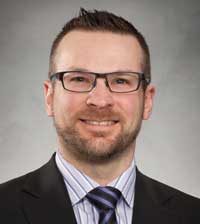I sit here at my kitchen table sculpting my second president’s message and I love the topic of automation. Why, you may ask? I have a tiny blister from gardening and my delicate engineer’s hands look forward to the day our robot overlords develop a rake-bot to prevent future generations from suffering as I do.
COVID-19 has shown that Saskatchewan engineers and geoscientists can continue to innovate and drive society forward even while working remotely from their homes. Whether it is Last Mountain Lake, Meadow Lake or Mississauga, APEGS license holders have shown great perseverance in non-traditional work structures. One silver lining coming out of these challenging times is the real incentive for engineers to increase the use of automation.
Take SaskEnergy, for example, and its advanced metering infrastructure featured in this issue. By automating the meter reading process, engineers bring a host of short- and long-term benefits to society.
In the short term, meter readers are not exposed to potential hazards in the field, fuel consumption and its environmental impacts are lessened and customers get timely data.
In the long term, I am excited to see what further automation the data gathered can enable. Picture a smart system that tunes its delivery, maintenance and asset management around the weather forecast, customer usage and all sorts of things someone smarter than me has already considered.
Private sector innovators like Delco Automation and Brandt are also increasing automation to the benefit of society. Their stories remind us of the important work engineers engage in to add intelligence to asset management (Delco and the Saskatchewan Hospital in North Battleford) and the health, safety and productivity benefits to workers from automated manufacturing (Brandt Smart Factory).
These successes must also be tempered by the moral and ethical questions rising from an increasingly automated world. How does an engineer design for the “Trolley Problem” of automated decision making? If someone is harmed by self-learning systems, who does APEGS discipline? How do you teach an automated system to balance health, the environment and the public interest? What guidance can a regulator provide? Will our robot overlords have to take the Professional Practice Exam? I am genuinely curious to see how our profession manages these fast-approaching quandaries.
Speaking of engineers inadvertently causing havoc, I am looking forward to our upcoming Annual Meeting in September. Plans are in full swing to deliver APEGS’ first ever virtual annual meeting. Now if we can only automate chairing Council meetings, l will be fully set.
P.S. – If you are still stuck at home, I encourage you to reflect on some of the great people and projects you know of in Saskatchewan and nominate them for an APEGS award. Nominating details are contained within this Edge and I am excited to see what is out there.
